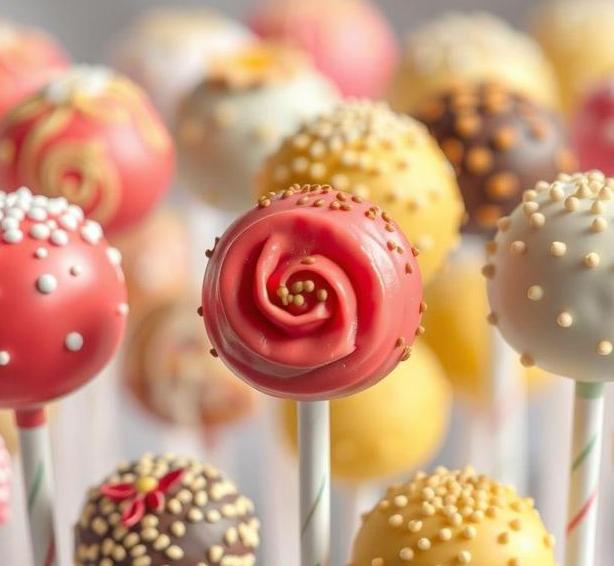Can Cake Pops Go Bad : What You MUST Know
Cake pops, those delightful bite-sized sweets that are both fun to eat and fun to make, have become a popular treat at parties, weddings, and other celebrations. The best part? You can customize them in almost any way, from flavors to coatings to decorations. However, as with any baked good, cake pops don’t last forever. Whether you’re making them for an event or storing leftovers, it’s important to know how long they stay fresh and how to store them properly.
But can cake pops go bad? And how can you tell when it’s time to toss them out? Let’s break it all down-from their shelf life to the signs of spoilage, along with tips for proper storage and preservation. If you love cake pops (who doesn’t?), then this guide is for you!
Can Cake Pops Go Bad?
Yes, cake pops can go bad, but the timeline depends on a few factors such as ingredients, storage conditions, and whether they’ve been coated with frosting or chocolate. Cake pops are essentially small, moist pieces of cake that are bound together with frosting or another creamy binder. This makes them a little more prone to spoilage compared to a traditional slice of cake.
Because of their high moisture content, combined with the sugars and fats in the frosting and chocolate coatings, they are more susceptible to bacterial growth and mold development if not stored properly.
Here are some of the main factors that affect how quickly cake pops go bad:
- Moisture: Cake pops are quite moist, making them prone to mold.
- Perishable Ingredients: Frosting, especially if it contains dairy products like cream cheese, has a shorter shelf life than dry cake.
- Coating: Chocolate or candy coating can help preserve the cake inside, but once it cracks or gets damaged, the cake is exposed to air, which accelerates spoilage.
So, yes-cake pops can go bad, but the timeline and severity depend on how they’re stored and what ingredients are used.
Shelf Life For Cake Pops

The shelf life of cake pops varies depending on how they’re made and stored, but here’s a general guideline:
- Room Temperature: If you’re planning on serving cake pops within a couple of days, they can usually sit out at room temperature for about 2 to 3 days. Keep them in a cool, dry place (like in a cake box or container) away from direct sunlight and heat.
- Refrigerated: When stored in an airtight container in the refrigerator, cake pops can last about 1 week. The cool temperature helps prevent bacterial growth and prolongs freshness.
- Frozen: For longer storage, freezing is your best option. If wrapped well in plastic wrap and stored in an airtight container or freezer bag, cake pops can last for up to 2 months. Freezing preserves both the flavor and texture, although the coating might suffer a bit once thawed.
Pro Tip: If you plan to freeze them, try freezing the cake pops individually first on a tray before transferring them into a container. This prevents them from sticking together.
Common Signs Of Spoilage
As much as you might want to savor every cake pop, it’s important to recognize when they’ve gone bad. Here are the key signs of spoilage to look out for:
- Sour or Off Smell: One of the first indicators that a cake pop has gone bad is an unpleasant, sour smell. This could be the frosting turning rancid, especially if it contains dairy or perishable ingredients like cream cheese or butter.
- Mold Growth: Moisture inside the cake can encourage mold to form. If you see fuzzy or discolored spots on the surface, it’s time to throw them away.
- Discoloration or Dryness: If the frosting or coating starts to discolor, or if the cake pop appears excessively dry and cracked, that could mean it’s past its prime. The once moist cake inside might turn stale and unappetizing.
- Changes in Texture: Cake pops should be soft and moist inside. If they become hard, crumbly, or overly sticky, they are likely spoiled. A change in texture is a clear red flag.
- Sticky or Oily Coating: If the chocolate or candy coating begins to get oily or sticky, it’s another sign that the cake pop has aged past its freshness.
How To Store Cake Pops?

Proper storage is key to prolonging the freshness of cake pops. Below are some storage tips to ensure that your cake pops stay as delicious as when they were freshly made.
Room Temperature Storage
- Containers: Store cake pops in airtight containers, or use a cake pop holder that keeps them upright. This protects the shape and prevents them from drying out.
- Keep Them Cool: If you’re not serving them immediately, avoid putting them in a warm spot, like next to the stove or in direct sunlight. Room temperature storage is only ideal for short periods-around 2 to 3 days.
- Avoid Refrigerating Too Early: Cake pops can dry out in the fridge if stored too soon after they’re made, especially if the coating is chocolate. Allow them to cool and firm up fully at room temperature before refrigerating.
Refrigeration
- Airtight is a Must: The most important thing to remember when storing cake pops in the fridge is to ensure they are in a sealed container. This prevents the cake from absorbing odors from other foods and keeps it moist.
- Keep Them Upright: To avoid any damage to the coating, store the cake pops upright in a container with dividers or in a cake pop stand.
Freezing
- Wrap Individually: To keep the cake pops fresh, wrap them tightly in plastic wrap before freezing. This prevents freezer burn and ensures that the coating stays intact.
- Use an Airtight Container: Place the wrapped cake pops in a freezer-safe container or bag to avoid exposure to air.
- Thawing: When you’re ready to enjoy them, allow the cake pops to thaw at room temperature. Do not thaw them in the microwave, as this can cause the coating to melt or become mushy.
Expert Tips
- Flavor Freeze: Cake pops freeze better when they’re made with firmer cakes, like pound cake. This helps maintain their texture when they thaw.
- Avoid Freezing Decorated Cake Pops: If your cake pops are decorated with delicate elements like sprinkles or drizzled chocolate, they might not freeze well. These decorations can become soggy or lose their texture.
- Pack and Transport Carefully: If you’re traveling with cake pops, use a secure container with a lid to prevent them from rolling around or becoming damaged.
- Consider Vacuum Sealing: If you’re storing a large batch of cake pops and want to keep them as fresh as possible for an extended period, you might want to invest in a vacuum sealer. This will remove all the air from the packaging, preventing spoilage.
FAQs
Can Cake Pops Go Bad If Left Out Overnight?
Yes, cake pops can go bad if left out overnight. Without proper storage, the moisture from the cake and the frosting can cause them to spoil or dry out, leading to a loss of flavor and texture.
How Long Can Cake Pops Last At Room Temperature?
Cake pops can typically last 1 to 2 days at room temperature, provided they are stored in an airtight container. Beyond that, the cake may become stale or the coating could melt, which affects the quality.
Can Cake Pops Go Bad In The Fridge?
Cake pops can last up to a week in the fridge if stored properly. It’s important to keep them in an airtight container to prevent them from absorbing odors from other foods and drying out.
How Can You Tell If Cake Pops Have Gone Bad?
Signs that cake pops have gone bad include a sour smell, discoloration, mold, or an off-putting taste. If the coating begins to crack or the cake inside is dry, it’s also a sign of spoilage.
Can Cake Pops Go Bad If Frozen?
When properly frozen, cake pops can last up to 2-3 months. Ensure they are wrapped securely in plastic wrap and placed in an airtight container or freezer-safe bag to maintain their quality.
Do Cake Pops Spoil Faster If They Have Frosting?
Yes, cake pops with frosting are more prone to spoilage because frosting contains dairy or other perishable ingredients. This can shorten their shelf life, especially at room temperature.
Can Cake Pops Go Bad If They’re Made With Cream Cheese Frosting?
Yes, cake pops with cream cheese frosting are more susceptible to spoiling. Since cream cheese is a perishable product, cake pops made with it should be stored in the refrigerator and eaten within 3-4 days.
Can You Store Cake Pops At Room Temperature For Longer Periods?
It’s not recommended to store cake pops at room temperature for extended periods. After 1-2 days, they may lose their freshness, and bacteria growth may become a concern.
What Is The Best Way To Store Cake Pops To Keep Them Fresh?
The best way to store cake pops is by placing them in an airtight container. If storing for longer than a couple of days, refrigerating or freezing them is ideal. Make sure they are well wrapped to prevent drying out.
Can The Chocolate Coating On Cake Pops Go Bad?
Yes, the chocolate coating on cake pops can go bad. If exposed to heat or humidity, the coating can melt, and over time, it may develop a white film (bloom) which affects the texture and flavor. Store them in a cool, dry place to prevent this.
